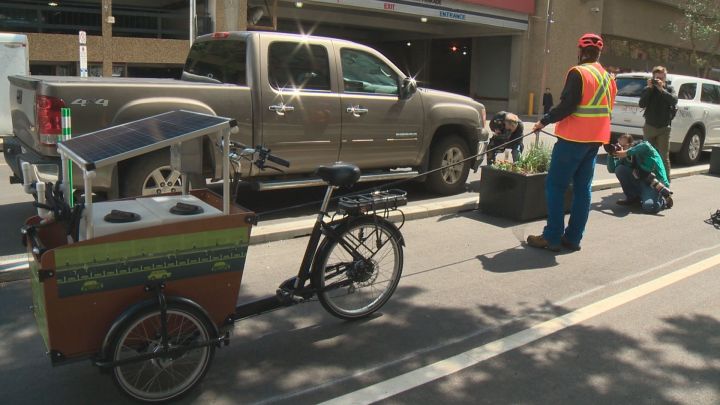It’s described as an innovative and cost-effective solution to maintaining the greenery along Edmonton’s downtown bike network. The city has purchased two solar-powered watering trikes to water the approximately 100 planters along the downtown bike lanes.

“A bike in a bike lane makes a lot of sense to people,” said Peter Mueller, a parks operations co-ordinator with the City of Edmonton.
“And the environmental aspect, I think, is terrific. There’s no noise, there’s no exhaust. People really, I think, get on board with that sort of innovation.”
It’s been about a month since the first stretch of Edmonton’s new downtown bike network opened, after much anticipation.
The $7.5-million network offers cyclists more than 7.8 kilometres of protected bike lanes and shared-use paths.
READ MORE: New Edmonton downtown bike network will be change for motorists
The city purchased two electric assist bikes to do the job. They’ve been equipped with solar-powered water pumps. Each bike has two 70-litre tanks, capable of watering between 15 to 20 planters.
Each bike with the pump system cost about $8,500.
“We did some cost analysis and we stayed away from trucks,” Mueller explained. “Because of the room involved, the interference with the bike grid and the road, the trucks aren’t a great solution. You’re either upsetting motorists or cyclists.
“We use these bikes for two seasons and the trucks, for that same amount of time, would exceed the cost of the bikes. We think we’ll get quite a few years of service out of these things.”
Olga Messinis, project manager of the downtown bike network, said the city used a three-quarter ton truck to do the watering before the bikes were ready, which was not ideal.
“It really fit with the theme of the bike network itself being a sustainable mode of transportation and offering a sustainable tool to do some of the work within the bike grid,” she said.
At the end of the summer, the planters will be loaded into a truck and hauled to the Muttart Conservatory for the winter.
Messinis said the bike network will be maintained through the winter under the city’s snow and ice policy.











Comments